Atlas more than a shrug as VW’s large SUV
By John Gilbert
BOERNE, Texas
Volkswagen needed a large SUV much more than the marketplace needed another large SUV, and that in essence, is why the Atlas came to be designed and built as an American demands.
If you were a fan of reading Ayn Rand, you could say that VW officials in Wolfsburg, Germany, decided, “We must have a larger SUV,” and Atlas Shrugged. Sorry about that.
The point is that if a consumer family loved its succession of Volkswagen vehicles, but grew past the point where everybody could fit inside a Golf, or a Jetta, or even a Tiguan or Touareg — which will seat four comfortably and five in a squeeze — then they would have to go off and buy a Tahoe, Explorer, Honda Pilot, any of several Toyotas, or any of a couple dozen other alternatives.
Thus it made sense that as a family outgrew its VW, the Atlas would give those customers a larger VW SUV to grow into. It has three rows of seats, foldable into various configurations depending on whether you need to haul people or luggage, or major pieces of equipment.
The Atlas is the largest vehicle Volkswagen has made, and it will be built in the new Chattanooga, Tenn., plant VW built for Passat sedans. But for the first media drives, Volkswagen decided to corral us in San Antonio, from where we were driven northward to the small town of Boerne, Texas, and stationed at the Tapatio Springs Hill Country Resort.
It is a fantastic facility, with an 18-hole golf course, and enough space to hold various presentation meetings, as well as a full-scale Texas barbeque. (I like barbequed brisket, but I don’t bother with it when there are also ribs available; there were ribs available at our patio dinner, cooked as perfectly as you could want.)
After we looked over the large exterior of the Atlas, senior product manager Mark Gillies began his presentation by explaining why the company picked the vast expanse of Texas for the intro drive. “The Atlas is big, and it looks right at home with all the big SUVs down here,” he said. Other officials added that it is designed, tailored and built in the U.S. “to fit American families.”
The Atlas looks the part, but the secret of success in that hotly competitive segment is how the vehicle feels, how it drives, and how flexible its game plan is executed. The Atlas is built on VW’s MQB platform, which is versatility personified. The entire Golf family, Jetta, Passat and Tiguan all share versions of that underpinning.
It didn’t take us long to find out how the plan was executed. Having dodged some severe rainstorms and tornadoes that swept through the area on that Sunday, we arose early Monday to hit the road. And the hills.
My driving partner, whom I shall call Sebastien, is a young journalist from Toronto who was anxious to learn all he could about Texas, so we discussed everything from Waylon and Willie, to Luckenbach, to the music capital and bats of Austin, and as much as I knew of the region we were venturing into.
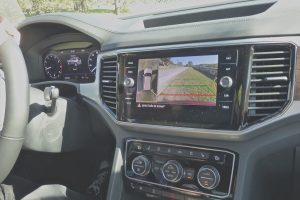
A large navigation screen covers the center of the dash with a sweeping view, as well as a 360 surround view of the vehicle.
We swept along a ribbon of asphalt as the highway followed a winding, twisting trajectory around numerous curves and up, down and between hills that sprouted in random fashion out of the densely wooded terrain, as if intending to surprise an unsuspecting motorist.
The heavy rain of the previous night turned most of the dried-up creekbeds into raging, near-flash-flood attitudes. I started behind the wheel of the new Volkswagen Atlas SL Premium, with 4Motion all-wheel drive and the VR6.
The very neat navigation system had been programmed with our route, and the Nav Lady kept us aware of or next turns. The lack of any shoulders on the narrow two-lane roadways offered good reason to stay alert as we cruised through what they call the “Hill Country” of central-west Texas, a little bit north of San Antonio and a little bit southwest of Austin.
The Atlas comes in base S ($30,500 to $33,700), S Launch ($33,500-$35,300), SE $34,990-$36,790), SE With Technology ($35,690-$38,890), SEL ($39,160-$42,690), and SEL Premium ($48,490), with features and equipment rising along with the sticker prices.
Engine options include the long-standing 2.0-liter turbocharged 4 with 235 horsepower and 258 foot-pounds of torque, running through an 8-speed automatic, and with 4Motion optional. The engine upgrade is the also-familiar narrow-angle 3.6-liter VR6 with 276 horsepower and 266 foot-pounds, and the AWD versions include the VR6.
It seems that VW made different packages for increasing feature content, with all sorts of driving aids and enhanced safety and connectivity, as well as fancier interior amenities that lead up to Atlas models loaded to the sunroof with options.
Latching onto the dark red SEL Premium gave us the larger 20-inch wheels, and as the top of the line Atlas, it felt solid and substantial without the hugeness that is part of a lot of large SUVs.
We should anticipate by now that any vehicle made by Volkswagen will trace curves with a flat attitude at any speed, and the Atlas did that, as I placed the outside front tire near the edge of the roadway and held precise lines toward the next hill and curve.
That worked on freeways and 4-lanes, and was even more critical in Hill Country, where the 2-lane highways had only a little grass to serve as shoulders, and a lot of nasty looking underbrush not far off the roadway. No problem.
Driving other models with the standard 18-inch wheels and fewer features, such as the SE model, was evidence that any Atlas will do for most “needs,” but the more loaded models are aimed at “wants” of SUV buyers.
We got to our lunch stop, at the delightful little town of Fredericksburg, a bit early. And as I was telling Sebastien about stopping in Luckenbach several years ago, he plugged it into the nav system and suggested we had time to make a quick side-trip there, right then.
We did that, and found expansion of the ancient cowboy town, but the main store, post office and back room where a bearded fellow would play the late Waylon Jennings classic “Luckenbach, Texas,” with only a minimum of urging.
The build quality of the Atlas is definitely vault-like, and the superb driving attitude only adds to the feeling of driving security. At a length of 198.3 inches, and with a 117.3-inch wheelbase, the Atlas looks taller than its 70 inch height. The towing capacity is only 2,000 pounds with any added hitch, while the factory hitch offers 5,000 pounds with enhanced oil and transmission coolers and beefed-up structure.
Perhaps more important statistics are the 20.6 cubic foot cargo capacity behind the upright third-row seat, which expands to a spacious 55.5 cubic feet with the third row folded down, and 96.8 with both the second and third rows folded clear.
With the lengthy standard equipment, which includes LED headlights, start-stop technology, rearview camera, smartphone connectivity with Apple CarPlay, Android Auto and MirrorLink, it’s remarkable that the option list goes on forever. LED taillights, a huge sunroof, power tailgate that opens with a wave of your foot under the rear bumper, a digital cockpit, ambient lighting, remote start, second-row captain’s chairs that slide nearly 8 inches, and can be heated.
Officials stressed that the third row is designed for adult comfort, not just kids. Safety factors are also available, such as brake assist and autonomous braking with pedestrian monitoring, blind spot monitor, rear traffic alert, lane assist, park distance control and maneuver parking, for parallel or perpendicular assist.
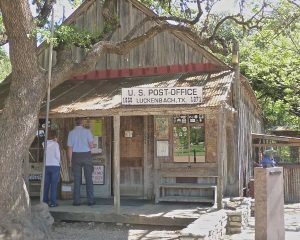
Luckenbach’s general store, post office, convenience shop and venue for country singers never changes.
Other refinements that will appeal to buyers are things like 12 liters of storage in the console between the front buckets, a customizable instrument panel with a 12-inch display, and a sound system that is among the best in the industry — a dedicated Panasonic Fender surround system. It has 480 watts blowing through 12 channels to 12 speakers.
We hit “Outlaw” on the satellite audio system, and let that Fender system blast out “Bob Wills Is Still the King,” and, of course, “Luckenbach,” for all of Hill Country to hear.


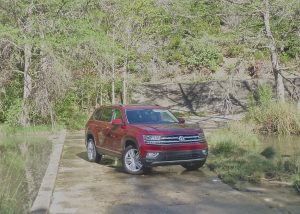

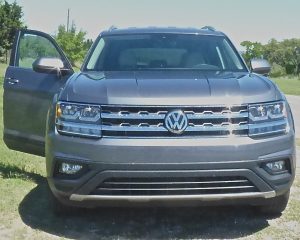
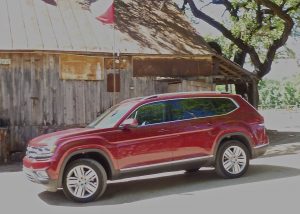
 John Gilbert is a lifetime Minnesotan and career journalist, specializing in cars and sports during and since spending 30 years at the Minneapolis Tribune, now the Star Tribune. More recently, he has continued translating the high-tech world of autos and sharing his passionate insights as a freelance writer/photographer/broadcaster. A member of the prestigious North American Car and Truck of the Year jury since 1993. John can be heard Monday-Friday from 9-11am on 610 KDAL(www.kdal610.com) on the "John Gilbert Show," and writes a column in the Duluth Reader.
John Gilbert is a lifetime Minnesotan and career journalist, specializing in cars and sports during and since spending 30 years at the Minneapolis Tribune, now the Star Tribune. More recently, he has continued translating the high-tech world of autos and sharing his passionate insights as a freelance writer/photographer/broadcaster. A member of the prestigious North American Car and Truck of the Year jury since 1993. John can be heard Monday-Friday from 9-11am on 610 KDAL(www.kdal610.com) on the "John Gilbert Show," and writes a column in the Duluth Reader.